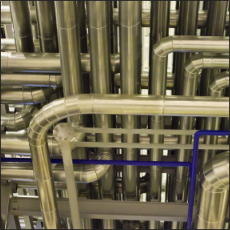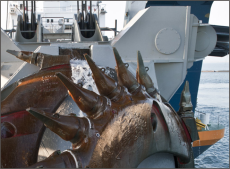21st Century Automation
The manufacturing world has long accepted high-tech automation and control systems as simply a way of doing business. It is almost impossible to walk through a modern manufacturing facility and not find computer controls and automated data acquisition systems. And it is becoming increasingly common to find these systems interfacing to high level business software packages, providing middle and upper management with production information, quality reports, etc.
It hasn’t always been this way. Although many manufacturing systems before the 1970s had control systems, these systems typically utilized hardwired relay logic for sequencing and safety interlocks and pneumatic controllers for process controls. This technology had many drawbacks. It was expensive to install and maintain. Modifications to the system required labor intensive wiring changes. Pneumatic controllers would drift and require continual maintenance. Production and quality reports typically consisted of an operator tracking production totals and defects on pieces of paper. Data to upper management was often inaccurate and sent too late to be useful.
The development of solid-state technology and the explosion of the computer-age, however, brought new automation products and systems. In the 1980s manufacturers started using digital control systems to control their production lines and processes. In the 1990s, graphical operator interfaces running on computers became commonplace. And now, in the 21st century, we see control systems so integrated into the manufacturing process that it’s hard to tell where the control system stops and the business system begins.
Dredging Industry Lags Behind
Unlike the rest of the manufacturing world, the dredging industry is only now being exposed to the concepts of computerized control and monitoring systems. Many new dredges manufactured in the US still utilize pneumatic and hydraulic technology for process control and information feedback. Production data, when it exists, is usually written down on a piece of paper. More often, actual production information isn’t obtained until a survey is done and compared to the original site survey. Real-time information showing where and how much the dredge is digging is often unavailable. Determining the depth that a dredge is digging at is usually determined with a calibrated stick or length of line hung overboard.
The dredging industry now finds itself playing catch-up to the manufacturing world. Dredge users and manufacturers are being bombarded with an array of new and confusing terminology. Acronyms such as PLC, HMI, IO, GPS, RTK, DPGS and OIT are completely foreign. Terminology such as nuclear densitometer, mass flow meter, digital interface, serial protocol and wireless network can be as confusing as a foreign language. Breaking through the confusion requires an understanding of the various pieces that make up a control and monitoring system. Kruse Controls, Inc. applies concepts to the dredging industry that were learned during their years servicing the manufacturing world. Working with us can help clear up the automation confusion and provide a clear understanding of how to apply automation technology in a way that best serves your purposes.
Looking At The Basics
Perhaps the simplest place to start is with a monitoring system. This is a system whose sole purpose is to automatically gather process information on the dredge. This information includes operating conditions such as oil temperature, engine speed, dredge pump discharge velocity, slurry density, tons per hours (TPH), etc. The purpose of monitoring this data is to provide the operator with an accurate indication of how his dredge is running and to allow him WORLD DREDGING Mining & Construction, to make informed adjustments to maximize his production. If this basic data is massaged, additional information can be derived. Examples of this are run-time hours, total production tonnage and quality data.
Operating parameters are monitored using sensors and transmitters. The sensors convert physical conditions to low-level electrical signals and the transmitters convert the low level electrical signals into standard electrical formats (e.g. magnetic signals from a flow sensor to a millivolt signal and then to a 4-20 mA current signal). The standard signals can be wired directly to digital displays that will provide a calibrated reading that an operator can use (e.g. 4-20mA flow rate to 0-1000 GPM display).
If it is desired to derive additional information from the data, the instrument signals must be sent to an intelligent device. In these cases, Kruse Controls, Inc. utilizes programmable logic controllers (PLC). The PLC is typically the heart of a monitoring or control system. A PLC is an industrially hardened device consisting of input and output modules (I/O), a microprocessor running a control program and, if required, communications modules to allow it to send and receive data from other devices such as computers, graphical displays, etc.
For example, the PLC can display an instantaneous density value, a velocity rate and, through calculations in the control program, a tons/hour production rate. In a monitoring system, the PLC might do little more than collect signals and send them to a single display for use by an operator. In control applications, as we’ll see later, the PLC’s program will monitor its inputs and automatically control on-board devices.
There are several options for displaying monitored information. At the lowest level, individual hardwired displays can be used for each signal. A more efficient solution is an operator interface terminal (OIT). An OIT is a graphic monitor that displays information on customizable screens. The highest level solution is a human machine interface (HMI) system, which is a sophisticated software package that runs on a computer workstation.
Similar to the OIT, the HMI displays data from the PLC but, unlike the OIT, can run other software packages and store data in databases for future evaluation. When faced with the question of which display to use, the integrators at Kruse Controls, Inc. will evaluate the customer’s needs and budget to determine the best display solution. Also factored in are the performance improvements that have been seen by simply providing the operator with real-time operating information.
Controlling The Dredge
Taking advantage of the capabilities of a PLC, the next step beyond merely displaying process information is controlling the process. This is referred to as closed loop control. These are references to control theory in which a condition is monitored and compared to a setpoint to determine an error. A response to the error is automatically made in an attempt to reduce the error to zero. In a very basic example, an engine temperature switch could be monitored. If the switch closes (providing an error) a cooling pump might turn on (trying to correct the error). A more complex example might be varying the position of a cooling valve to maintain the engine temperature at a specific setpoint.
In both of these examples, the PLC monitors the process variable (PV) through its input, determines how to respond based on its program and controls the control variable (CV) through its output. In the discrete on/off example, the control program utilizes basic logic algorithms. In the more complex example, the control program might utilize a PID algorithm in which the response to the error is programmed via three tuning constants known as proportional response (P), integral response (I) and derivative response (D). More complex applications might utilize a combination of these, and other, control techniques.
Kruse Controls, Inc. has applied closed loop control techniques to a number of on-board dredge applications. Although these techniques and applications are unique, at their core is the same basic closed loop concept. Many of the algorithms were developed to mimic the manual controls that an operator would normally do. To serve as examples of what can be done on a dredge, here are some of the control applications developed by Kruse Controls, Inc.:
- Automatically control ladder swing speed to maintain an optimum pump suction pressure
- Automatically detect a wall and raise the ladder if the swing pressure is high, the cutter pressure is low and the density is low; restore the ladder once the process conditions return to normal;
- Automatically control slurry concentration by monitoring density and varying the opening of the suction side relief valve;
- Automatically detect a line plug by monitoring discharge velocity and clear the plug by automatically raising the ladder; automatically lower the ladder once the discharge velocity is restored;
- Determine when a cave in occurs by monitoring for high suction vacuum and automatically move the dredge back to clear the ladder;
- Monitor discharge velocity and automatically control dredge pump speed to maintain on optimum velocity;
- Automatically control the winches (and/or spuds) to move the dredge backwards and forwards;
- Monitor winch cable tension and adjust winch drives to keep a constant, safe tension.
Global Positioning Systems
At its most basic, a global positioning system (GPS) utilizes a receiver to satellite link to calculate its coordinates on the earth’s surface. A basic GPS system uses a single receiver and three satellites to determine position coordinates to within 10 ft. This system is what is typically found in car and personal GPS systems. A more advanced GPS system is differential GPS (DGPS) which uses four satellites. Using geometric calculations and a technique known as trilateration, the DGPS can provide surface coordinate accuracy to within 3.0 ft. The highest commercially available GPS system is the real-time kinematic GPS (RTK GPS) system. The RTK GPS system expands on the DGPS system by adding a base station set at a fixed location with known coordinates. It also provides more sophisticated error handling technology. This system provides an accuracy of less than an inch. It also has the ability to provide the elevation relative to sea level.
Determining which GPS system to use requires an analysis of needs versus budget. As may be expected, the more accurate systems cost significantly more than the base GPS. Often times a general understanding of where the dredge is located is all that’s required. In this case a relatively inexpensive GPS with a local position display will suffice. If a more accurate understanding of location is required, DGPS or RTK GPS might make sense.
In the context of an automation system, the GPS can be viewed as a sophisticated sensor. By interfacing it to a PLC and HMI, Kruse Controls, Inc. can use it to display position coordinates and digging elevation, alarm operators when digging outside of plan lines or below permit levels and even use it to control the dredge.
Contour dredging
Contour dredging is a great example to look at as it ties together the various automation concepts previously discussed. The need for contour dredging is often seen in the dredging of reservoir ponds where cutting a tiered, sloped side wall is necessary. Other applications for contour control are in environment dredging, channel dredging and marina dredging. In these cases, a specific amount of material must be removed to a pre-determined depth. In both of these cases, cutting above or below the desired depth is not acceptable and can lead to rework, cost overruns and financial penalties.
Contour dredging requires knowing where the cutter head is at all times. Kruse Controls, Inc. accomplishes this by interfacing various sensors and a GPS system to a PLC. The GPS provides the PLC with the exact coordinates and elevation of a point on the dredge. As this point is offset from the cutter head, sensors are utilized to provide position information for the ladder.
Inclinometers (sensors that monitor an object’s angle) and encoders (smart sensors that provide rotational position) provide information to the PLC about the position of the ladder. Using a collection of trigonometric algorithms in the PLC and knowing the position of the dredge from the GPS, Kruse Controls, Inc. can calculate the position of the cutter head to within one inch of accuracy.
As the ladder is swinging along a cut, the PLC continually compares where the cutter head is to where it should be along the desired cut line. If there is an error, the PLC can raise, lower and swing the ladder as appropriate to reduce the error. The sophisticated control algorithms in the PLC program minimize the cutter position error, causing the resulting cut to be smooth and at an accurate depth.
Conclusion
This article has attempted to provide a basic overview of modern automation systems and how they can be applied to the dredging industry. But this is only the beginning of what can be accomplished. The PLC and HMI can serve as the foundation for additional levels of automation. Automatically storing process information in databases for future use is common-place. Capturing and storing downtime information can help identify and solve maintenance problems. Wireless networking technology allows on-shore plants and dredges to communicate and coordinate their activities. Creating and automatically emailing production and downtime reports is now possible. With an understanding of current capabilities and a little imagination, the potential to utilize automation has never been greater.












